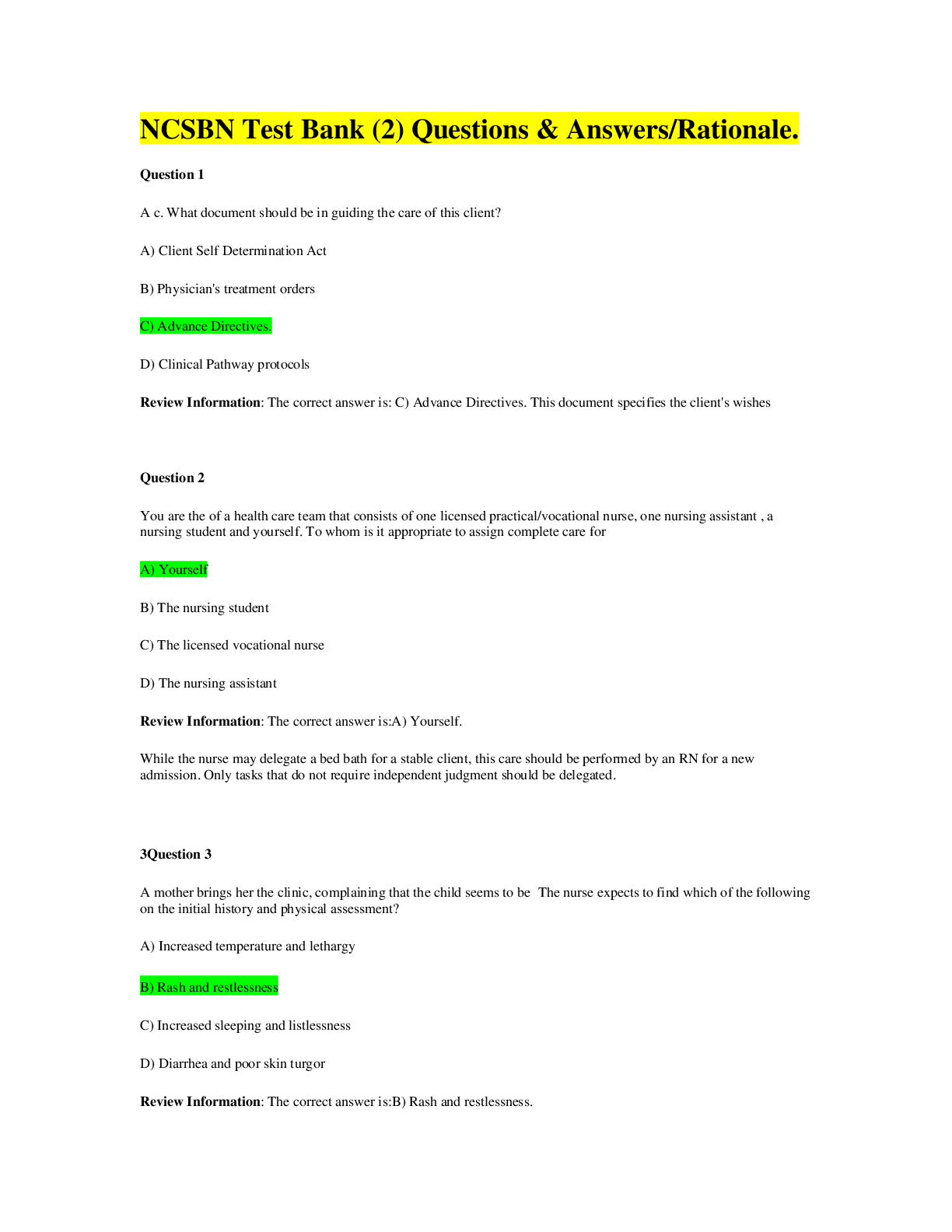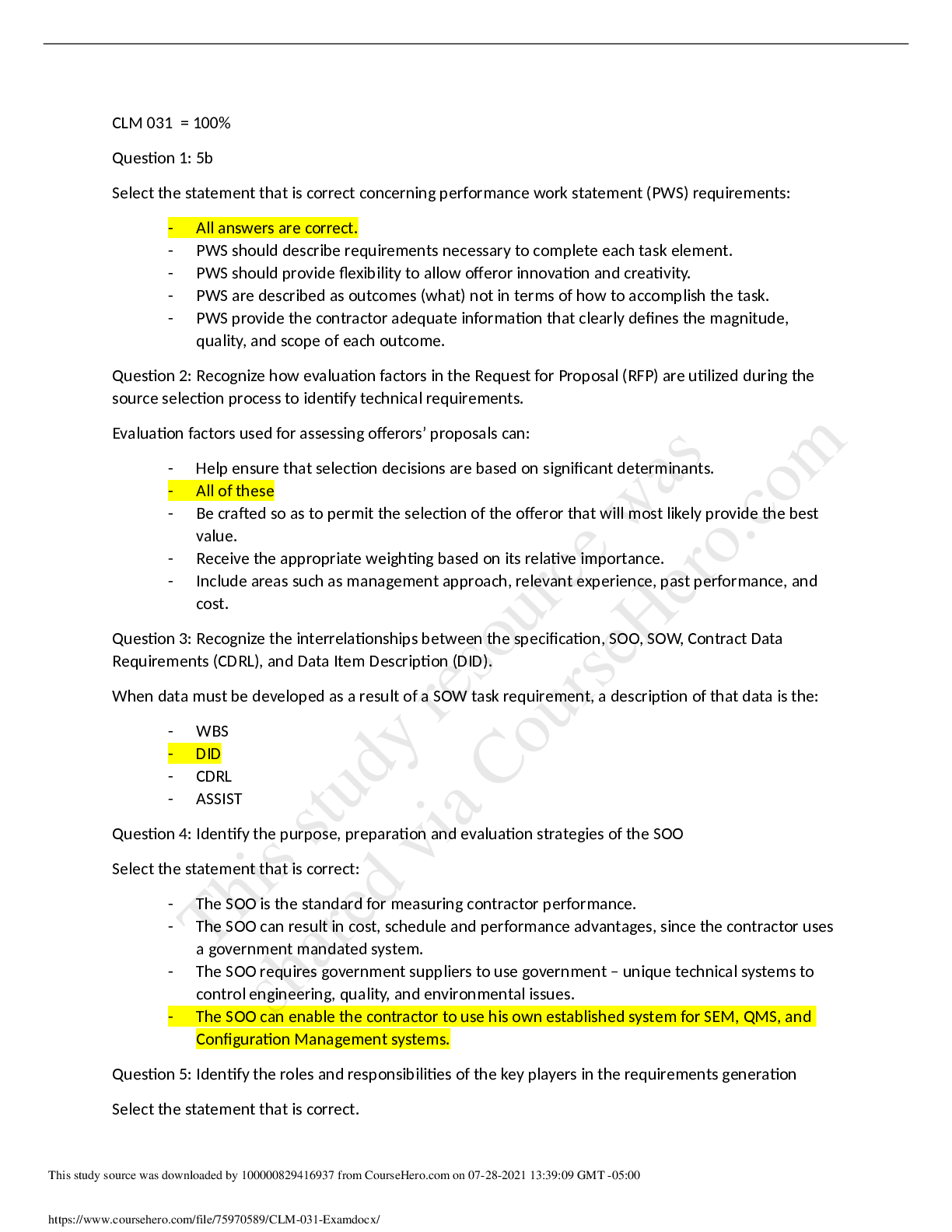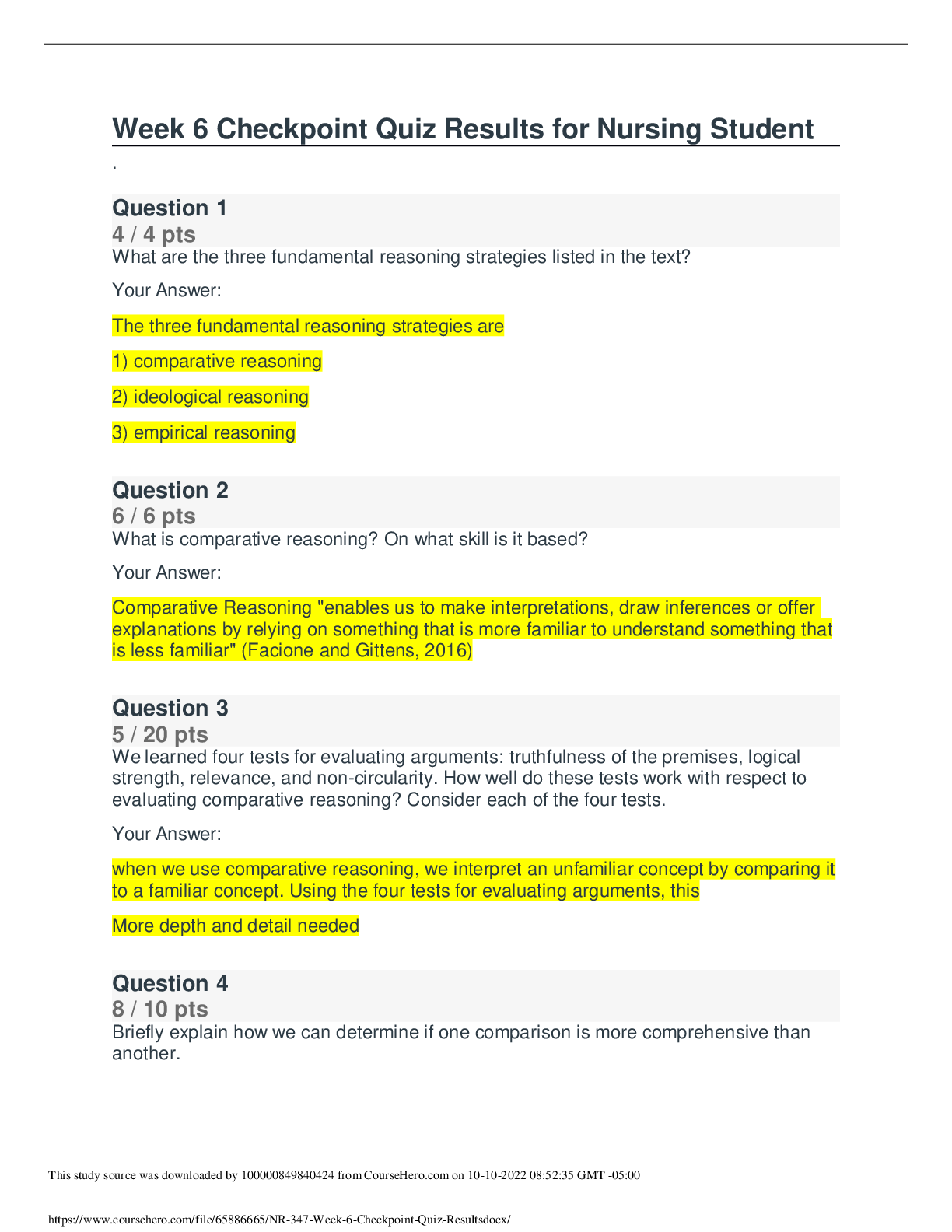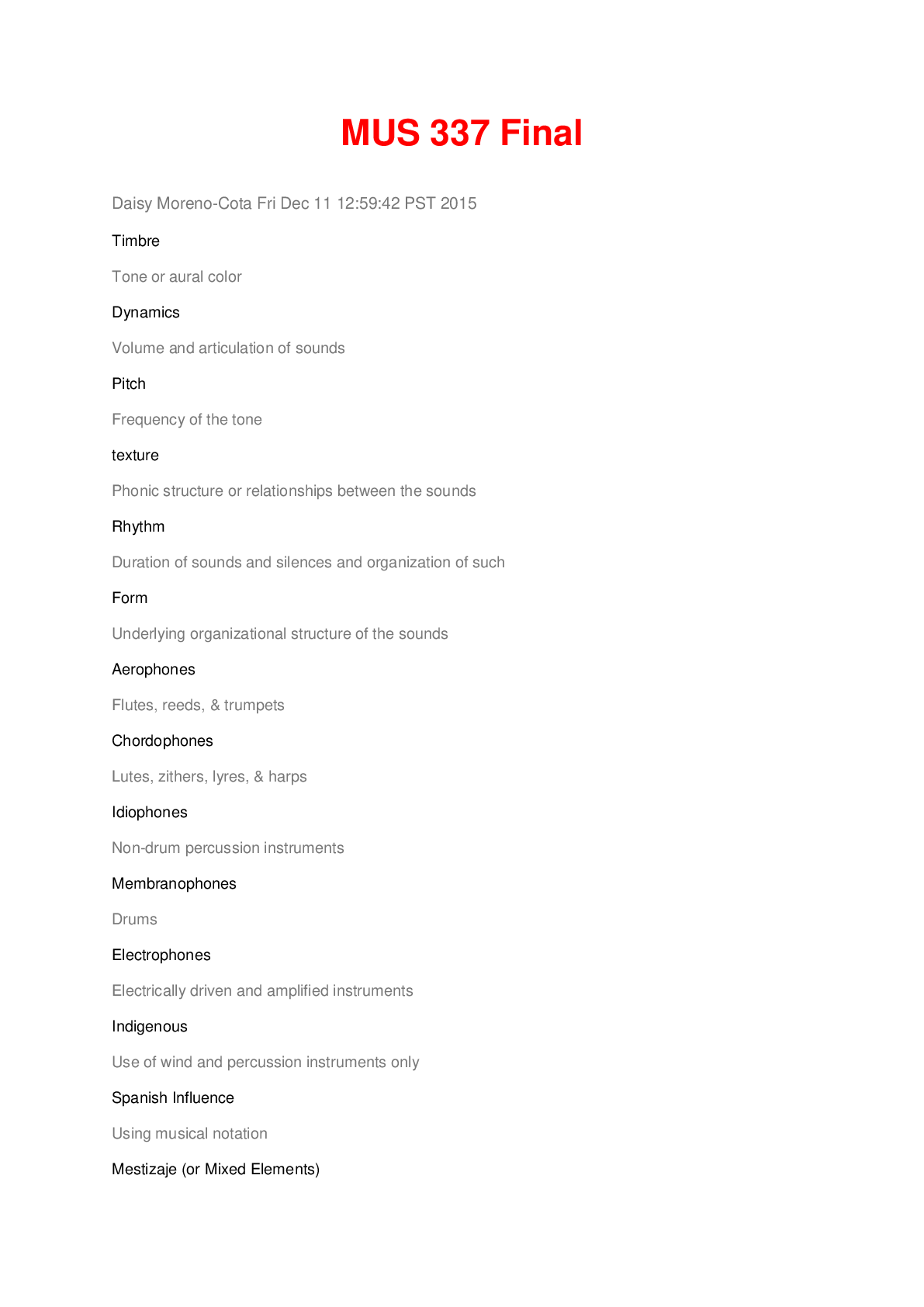Physics > QUESTIONS & ANSWERS > GIZMOS: Week 10 Online Lab: Crumple Zones (All)
GIZMOS: Week 10 Online Lab: Crumple Zones
Document Content and Description Below
Week 10 Online Lab: Crumple Zones Explore Learning Gizmo: Crumple Zones For this assignment, you'll use a Gizmo at the Explore Learning web site. Before you begin: • You may want to prin... t this document so that you can note observations as you work with the gizmo. Later, you can type your answers into the Word document and upload it with this assignment form. • All questions to answer are contained in this document. You don’t need to answer any questions at the Explore Learning site. • This lab has a Prior Knowledge piece, a Warm-Up piece, and Activity A, B, and C. • You must answer in a different colored font (-1 point) ________________________________________ FINDING THE GIZMO Follow these steps to find the Gizmo: • Go to the Explore Learning website: http://www.explorelearning.com/. • If you have not yet enrolled in the class -- In the upper right hand corner, click on Enroll in a Class. • The class code you need is 6FZRUV6SEM (note - these are all capital letters). • Click on Continue. • If you have used the Explore Learning site before you should be able to log in using your MNOHS username and password (for example, mnohs10ajones / piano227). If you have never used Explore Learning before, you’ll need to register using your MNOHS username and password with the class code. In other words, the class code is only needed once! • Once inside the Physics course, look for the Gizmo called Crumple Zones and click on Launch Gizmo. Answer all questions below in this Word document. When you are ready, upload the document to your assignment file. Vocabulary: acceleration, airbag, collision avoidance system, crash test dummy, crumple zone, force, kinetic energy, Newton’s laws of motion, safety cell, seat belt, work, work-energy theorem Prior Knowledge Questions (Do these BEFORE using the Gizmo.) Two burglars run down an alley at night, trying to escape the cops. Jack is carrying a rigid metal safe. Jill is carrying an armful of antique quilts. In the pitch dark, they both collide headlong into a concrete wall. 1. Who do you think will be hurt more in the collision, and why? 2. During a car crash, what features of the car might act like either Jack’s safe or Jill’s quilts? Gizmo Warm-up When cars were first invented, the safety of passengers was not a great concern. As vehicles grew larger and faster, accidents became more deadly. Safety features went from being a rare luxury to a legal requirement. In the Crumple Zones Gizmo, you will design cars that will help a crash test dummy survive a collision. 1. To begin, do not make any changes to the DESIGN tab of the Gizmo. Select the CRASH TEST tab, and click Play ( ). After the crash, click Slo-mo replay. What happens? 2. Select the RESULTS tab to read about the results of the crash. Do you think a passenger would have survived this car crash? Explain. Activity A: Surviving a crash Get the Gizmo ready: • Click Reset ( ). • On the DESIGN tab, check that Sedan is selected. Introduction: Modern vehicles contain features designed to keep passengers safe in a crash. The crumple zone in the front of the car slows the car gradually and increases stopping time. The safety cell is a rigid cage that prevents passengers from being crushed. Inside, seat belts and airbags prevent the driver from hitting the windshield, steering wheel, or dashboard. Question: How does a crumple zone help protect a passenger? 1. Make a hypothesis: On the DESIGN tab, look at the parameters you can control. What settings do you think will make the safest car? Set up the Gizmo, and then fill in below. Crumple zone lengthCrumple zone rigidity: Safety cell rigidity: Seat belt present? If present, seat belt stiffness Air bag present? If present, air bag rigidity: 2. Test: On the CRASH TEST tab, check that the Car 1 speed is 16 m/s, or about 35 miles per hour (mph). Click Play. After the crash, select the RESULTS tab. A. By what percentage did the crumple zone deform? Safety cell B. Did the dummy hit the steering wheel? C. What was the maximum force on the dummy? D. How likely was the dummy to survive? In this simulation, forces are measured in kilonewtons (kN). One kilonewton is equal to 1000 newtons, or the force of a 225-pound (102 kg) person standing on your chest. While many factors affect survival, only the maximum force and safety cell collapse are considered here. 3. Experiment: On the DESIGN tab, set the Crumple zone length to 100 cm and the Safety cell rigidity to 2000 kN. Set the Seat belt stiffness to 50 kN/m and turn off the Airbag. For each Crumple zone rigidity setting, run a 16 m/s crash test and enter the results below. Crumple zone rigidity Crumple zone deformation Dummy displacement Max. force on dummy Likelihood of survival 100 kN 200 kN 300 kN 400 kN (Activity A continued on next page) Activity A (continued from previous page) 4. Evaluate: Look at the results of your experiment. What was the relationship between crumple zone rigidity, crumple zone deformation, and maximum force on the dummy? 5. Infer: For a 1.00 m (100 cm) crumple zone, how much deformation do you think is needed in order to keep the passenger the safest? Explain your answer: Activity B: Modern safety features Get the Gizmo ready: • Click Reset. • On the DESIGN tab, check that Sedan is selected. Introduction: The idea of a crumple zone was conceived by Béla Barényi in 1952 and first used in the 1959 Mercedes W111. Seat belts were also first widely used in the late 1950s. More recently, airbags and collision avoidance systems (CAS) were introduced. Question: How do modern safety features and body types help keep passengers safe? 1. Experiment: Set the Crumple zone length to 90 cm, the Crumple zone rigidity to 1000 kN, and the Safety cell rigidity to 1000 kN. Turn off the seat belt and the airbag. These settings represent a 1950’s car with no crumple zone, seat belt, or airbag. A. On the CRASH TEST tab, set the Car 1 speed to 16 m/s. Click Play. What happened to the dummy? B. Turn on the seat belt and set the Seat belt stiffness to 100 kN/s. Run another crash. What happened? C. Set the Crumple zone rigidity to 250 kN and run another test. What happened? D. How did the crumple zone and seat belt work together to keep the driver safe? 2. Test: An airbag is designed to quickly inflate on impact, then deflate as the passenger hits the bag. Invented in the early 1970s, airbags did not become widespread until the 1990s. Using the crumple zone and safety cell settings above, experiment with the seat belt to find the lowest possible force on the dummy. Then, experiment with just the airbag. Finally, include both the seat belt and airbag. Report your findings below. Setup Seat belt stiffness Airbag rigidity Max. force Seat belt only 100 (No airbag) 16.55 kN Airbag only (No seatbelt) 30 30 kN Seat belt and airbag 100 30 45.36 kN How did the seat belt and airbag work together to keep the driver safe? 3. Experiment: Another modern safety innovation is the collision avoidance system, or CAS. A CAS will apply the brakes when it senses an imminent collision. The brakes can slow the car by about 8.8 m/s for each second they are engaged. Click Reset. On the CRASH TEST tab, select Enable collision avoidance system (CAS). Drag the car to the far right of the track at the bottom of the Gizmo, then click Play. What were the results of this test? 4. Explore: Click Reset. In some cases, there will not be enough time for the car to completely stop before the crash occurs. However, the CAS can still be useful. On the CRASH TEST tab, set the Car 1 speed to 23 m/s (about 50 mph). Play a crash without the CAS, and then run another test with the CAS on. What did you find? Activity C: The work-energy theorem Get the Gizmo ready: • Click Reset. • On the DESIGN tab, select the SUV body type. Introduction: In designing a safe vehicle, the goal is to minimize the force on the passenger during a crash by maximizing the stopping time and distance. In this process, it is helpful to know the minimum force that is possible. One way to find this force is to consider how the kinetic energy of the dummy relates to the work done in stopping the dummy. Question: How can you determine the minimum possible force that acts on a passenger? 1. Calculate: The energy of a moving object is described by its kinetic energy, in which KE = ½ mv 2. Work is the product of force and distance: W = Fd. The work-energy theorem states that work changes the kinetic energy of an object: W = ΔKE. This means that the work required to stop an object is equal in magnitude to the kinetic energy of the object. A. Work is equal to Fd, and work is also equal to ΔKE. Combine these relationships to write an equation that relates force and distance to the change in kinetic energy. Then, rearrange this equation to solve for force. B. If the goal of a safety system is to minimize the force, should the distance the dummy moves during the car crash be very large or very small? Explain your answer. C. Suppose a car has a 1.00 meter crumple zone. The distance from the dummy to the steering wheel is 0.50 m (50 cm). After impact, if the crumple zone collapses completely, how far could the dummy go before hitting the steering wheel? Maximum distance dummy could be displaced: D. The dummy has a mass of 50 kg (110 lb). If the dummy is traveling 16 m/s at the time of the crash, what is the dummy’s initial kinetic energy? joules (J) E. ΔKE = KEfinal – KEinitial. If the dummy comes to a stop, what is ΔKE? F. The work-energy theorem can be rewritten as F = ΔKE ÷ d. If the distance and kinetic energy change are known, you can solve for the force. Based on your answers to questions C and D, what constant force will stop the dummy? G. Convert the force to kilonewtons. (Activity D continued on next page) Activity D (continued from previous page) 2. Test: In the Gizmo, set the Crumple zone length to 100 cm. On the CRASH TEST tab, set the Car 1 speed to 16 m/s. Click Play, wait for the end of the crash, then look at the Summary data on the RESULTS tab. A. What is the lowest possible maximum force on the dummy? B. The RESULTS tab shows the magnitude of the force on the dummy. (Since magnitude does not deal with direction, it has no sign.) How does the magnitude of this force compare to the magnitude of the force you found in question 1G? C. Suppose the dummy had a velocity of 24 m/s before the crash and the crumple zone had a length of 1.20 m. What is the lowest possible force on the dummy in this case? Show your work and check your answer with the Gizmo. Minimum force on dummy: 3. Calculate: In the simplified situation shown in the Gizmo, the exact design of the crumple zone is not considered. Instead, the crumple zone is modeled as a semi-rigid structure that exerts a constant force on the car as it collapses. (This model is similar to how real-world crumple zones act.) The more rigid the crumple zone, the greater this constant force will be. You can use the work-energy theorem to determine the ideal constant force the crumple zone exerts. On the DESIGN tab, select the SUV body type and set the Crumple zone length to 100 cm. Note the mass of the SUV is 2,000 kg. On the CRASH TEST tab, set the starting speed to 16 m/s. A. What is the kinetic energy of the SUV, in joules? B. How far can the crumple zone collapse, in meters? C. What force (in kN) must the crumple zone exert in order to stop the car as it collapses completely? ? Check your answer in the Gizmo. 4. Think and discuss: No matter what you do, you will not be able to get the maximum force on the dummy exactly equal to the lowest possible maximum force because of the design of the airbags and seat belt. In the Gizmo, the seat belt is modeled as a spring, so the force of the belt increases as it is stretched. The airbag takes a few milliseconds to get into position. As a result, the dummy does not hit the airbag right away. How do these limitations affect how well the safety system can protect passengers in the car? What aspects of these systems can be improved? Write down your thoughts below. [Show More]
Last updated: 1 year ago
Preview 1 out of 8 pages

Reviews( 0 )
Recommended For You
*NURSING> QUESTIONS & ANSWERS > NCSBN TEST BANK for the NCLEX-RN & NCLEX-PN. Contains More than 2000 Q&A Plus Review and Rationale in 517 PAGES. (All)

NCSBN TEST BANK for the NCLEX-RN & NCLEX-PN. Contains More than 2000 Q&A Plus Review and Rationale in 517 PAGES.
NCSBN TEST BANK -for the NCLEX-RN & NCLEX-PN. Updated 2022/2023. Contains More than 2000 Q&A Plus Review and Rationale in 517 PAGES. (All Testable Questions for NCLEX-RN & NCLEX-PN)
By Expert1 , Uploaded: Jul 28, 2020
$20
Business> QUESTIONS & ANSWERS > CLM 031 EXAM (All)

CLM 031 EXAM
CLM 031 = 100% Question 1: 5b Select the statement that is correct concerning performance work statement (PWS) requirements: - All answers are correct. - PWS should describe requirements necessary...
By Book Worm, Certified , Uploaded: Nov 03, 2022
$5
*NURSING> QUESTIONS & ANSWERS > PHIL 347 Week 6 Checkpoint Quiz. Score 100/100 (All)

PHIL 347 Week 6 Checkpoint Quiz. Score 100/100
Question: What are the three fundamental reasoning strategies listed in the text? Question: What is comparative reasoning? On what skill is it based? Question: We learned four tests for evaluating...
By Amanda Rosales , Uploaded: Mar 24, 2021
$7
Business> QUESTIONS & ANSWERS > BUSINESS 1007 (All)

BUSINESS 1007
BUSINESS 1007 07 Key 1. (p. 178) Managers utilize organizational resources such as employees, information, and equipment to accomplish goals. 2. (p. 178) The main job of managers today is to w...
By Kirsch , Uploaded: Oct 19, 2019
$6
Anthropology> QUESTIONS & ANSWERS > KOR 352 FA19 101 week 8 Quiz. Already Graded A (All)

KOR 352 FA19 101 week 8 Quiz. Already Graded A
KOR 352 FA19 101: Week 8 Quiz Question 1 (0.25 points) Which of the following is not true of Kim and Finch’s observations during their field research in South Korea from 1997 to 2000? Question 1 o...
By Kirsch , Uploaded: Oct 17, 2019
$9
E-Commerce> QUESTIONS & ANSWERS > ESOC 316 Digital Commerce - University Of Arizona. Midterm Quiz. 20 Q&A. 100% Score (All)

ESOC 316 Digital Commerce - University Of Arizona. Midterm Quiz. 20 Q&A. 100% Score
ESOC 316 Digital Commerce - University Of Arizona. Midterm Quiz. 20 Q&A. 100% Score ESOC316 MIDTERM QUIZQuestion 6 (1 point) Saved Information has several properties that make information goods...
By Kirsch , Uploaded: Oct 15, 2019
$9.5
Marketing> QUESTIONS & ANSWERS > Marketing Management Chapter 2 to Chapter 10 Q&A (All)

Marketing Management Chapter 2 to Chapter 10 Q&A
Chapter 2 to Chapter 10 Chapter 2: Developing Marketing Strategies and Plans GENERAL CONCEPT QUESTIONS Multiple Choice 66 Chapter 1: Marketing: Managing Profitable Customer Relationships...
By Kirsch , Uploaded: Oct 14, 2019
$10
Marketing> QUESTIONS & ANSWERS > MKT 530 Customer Relationship Management. 155 Questions and Answers (All)

MKT 530 Customer Relationship Management. 155 Questions and Answers
MKT 530 All Questions and Answers MULTIPLE CHOICE. Choose the one alternative that best completes the statement or answers the question. 1) As the manager of an organization that is att...
By Kirsch , Uploaded: Oct 14, 2019
$10
Art> QUESTIONS & ANSWERS > MAS 337 Exam 1. Graded A (All)

MAS 337 Exam 1. Graded A
MAS 337 Exam 1 Match the son with its corresponding region. 1.Oaxaca 2.Veracruz 3.Michoacan 4.Jalisco 5.Hidalgo 1. Son istemeno 2. Son Jarocho 3. Son Abajeno 4. Son Jalisciense 5. Son Huast...
By Kirsch , Uploaded: Oct 14, 2019
$6
Art> QUESTIONS & ANSWERS > MUS 337 Final Exam Graded 100%. (All)

MUS 337 Final Exam Graded 100%.
MUS 337 Final Daisy Moreno-Cota Fri Dec 11 12:59:42 PST 2015 Tone or aural color Volume and articulation of sounds Frequency of the tone Phonic structure or relationships between the sounds Dura...
By Kirsch , Uploaded: Oct 12, 2019
$9
Document information
Connected school, study & course
About the document
Uploaded On
Jan 14, 2021
Number of pages
8
Written in
Additional information
This document has been written for:
Uploaded
Jan 14, 2021
Downloads
0
Views
354






